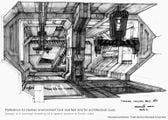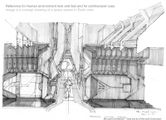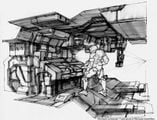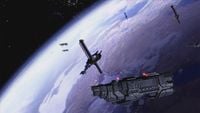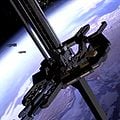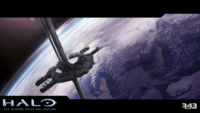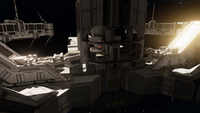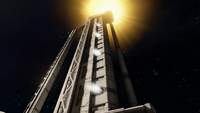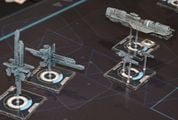Orbital defense platform
From Halopedia, the Halo wiki
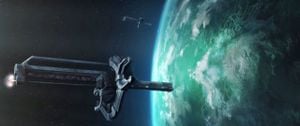
- "That MAC gun can put a round clean through a Covenant capital ship."
- — Avery Johnson, describing the gun of a Moncton-class orbital weapons platform.[1]
An orbital defense platform (ODP)[2], or orbital weapon platform (OWP), is a kind of armed satellite employed by the United Nations Space Command for defensive purposes. They can range massively in size and scope, and are frequently deployed in a geosynchronous orbit around a given world to act as a defensive line against a potential invading enemy force.[3][4] Within the UNSC, orbital weapons platforms are assigned the hull classification symbol OWP.[5]
Overview[edit]
Design details[edit]
Orbital weapons platforms serve to guard their charges via a number of means. The term is a loose descriptor that can encompass a range of satellite types, ranging from small and/or unmanned satellites that consist simply of a missile pod linked to a targeting array and communications relay, up to the massive manned space stations that form the most predominant and iconic imagery of the concept. The largest of these are built around a core capital-scale Magnetic Accelerator Cannon (MAC), colloquially referred to as a "big stick", and serve as some of the largest and most powerful examples of MAC weaponry available to humanity.[3][4][6]
Alongside their primary defensive weaponry, ODPs may also equip a number of secondary armaments to aid in their own defence. These include point-defense guns, such as in case of the M606 Goalkeepers included on the Moncton-class. Larger OWPs usually also equip hangar support facilities for dropships and strikecraft, with the precise examples carried varying across the fleet. OWPs are deployed in battle clusters of (in the case of the Moncton) three stations, each designed to mutually support and reinforce one another. As such, each carries a slightly different loadout, allowing the three to each specialise in a particular collateral function and cover one another's bases.[5]
Power generation[edit]
OWPs may generate their electrical power through a number of means. Some designs maintain their own internal fusion reactors for fully-independent operation, and can make use of liquid metal capacitor cells to store charge for the primary weapon. In emergency circumstances, it is possible to dock a friendly UNSC warship to the station, to make use of its reactor to aid the station in power cycling.[5] The most powerful rapid-fire designs - consisting of the Erőd-class deployed over Reach - are so power-hungry as to make even onboard fusion reactors unsustainable. Instead, these few stations are manually tethered to ground-based generator facilities. While providing vastly higher amounts of power for the weapon systems of the platform, these separate generators also serve as a key defensive weakness for the station, and are susceptible to forces on the ground in the event of an invasion.[7]
Usage[edit]
Within the UNSC, orbital weapons satellites are typically manned, maintained and operated by the UNSC Air Force[8], presumably administered by the Orbital Defense Command.[9] However, they may be employed for collateral and administrative functions by the UNSC Navy. For example, the platform Cairo Station served as the command centre for Fleet Admiral Terrence Hood during the Battle for Earth in late 2552, alongside hosting a naval ceremony to promote the survivors of the Battle of Installation 04.[1]
Variants[edit]
Several kinds of OWP are employed by the UNSC, the most prominent of which consisting of large space stations built around a central core MAC in a similar fashion to most other UNSC starships.
Erőd-class[edit]
- Main article: Erőd-class orbital weapon platform
The Erőd-class OWPs were, during their tenure, among the most powerful stations ever constructed. They consisted of a single rapid fire Super MAC that was considered a threat to even Covenant starships, though relied upon separate ground-based generators for their power. This Achilles heel ultimately proved their downfall during the space battles in orbit over Reach during the planet's fall. Prior to this, Erőds formed a core component of Reach's twenty-strong OWP lineup.[7]
Quezon Station, one of the Erőd-class ODPs over Reach, alongside its battle cluster.[7]
Moncton-class[edit]
- Main article: Moncton-class orbital weapon platform
The Moncton-class OWPs serve as the primary defensive battlements surrounding Earth, with at least one example also constructed over Reach.[10] They were in service by at least 2517[10], with the onset of the Human-Covenant War in 2525 spurring on a massive construction project for the constellations of Moncton satellites over Earth. By 2552, this program was still incomplete, by which time the planet held around three hundred stations in its defence.[11][1]
Cairo Station alongside its battle cluster, consisting of Athens Station and Malta Station.
Other OWP classes[edit]
A number of hitherto-unnamed OWPs have been observed over various colony worlds.
An unnamed ODP over Reach, firing its main gun. Unlike regular ODPs in which the cannon is aligned vertically with the station's axis, the gun here is laterally-mounted.[12]
An unnamed ODP uncovered by 343 Guilty Spark within the data banks of UNSC Pillar of Autumn.[13]
Operational history[edit]
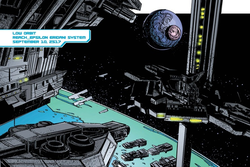
Reach[edit]
A Moncton-class orbital weapon platform was in place by May 2517 over Reach.[10] A number of Reach's ODPs were online by 2527.[14] By August 2552, Reach was protected by 20 orbital defense platforms, with at least one being an Erőd-class orbital weapon platform.[3]
During the Fall of Reach, the orbital defense platforms inflicted massive losses on the Covenant armada in the opening stages of the battle, as well as providing fire support for ground forces on Reach. Large numbers of UNSC forces were deployed to protect the orbital platforms' planetside power generators, but they ultimately fell against determined enemy assaults. The disabling of the defense platforms was a major factor on the battle's outcome.[15]
Earth[edit]
The outbreak of the Human-Covenant War prompted a massive expansion of Earth's defenses. Even as late as the Battle of Reach preparations had not yet been completed; a series of new platforms above Earth were set to come online on September 14.[11] By October 2552, some 300 ODPs were operational.[16] Many of Earth's ODPs were named after points of interest that they roughly kept station over.
A portion of the 300 platforms first saw action at the early stages of the Battle for Earth. Athens Station and Malta Station were each destroyed by antimatter charges installed by Covenant boarding parties, while Cairo Station only narrowly avoided the same fate as the other platforms thanks to Master Chief's removal of the bomb on board.[1] The ODPs were used throughout the drawn-out Battle for Earth after more Covenant fleets began to arrive in the following days and weeks,[17] but the Covenant might have already destroyed numerous stations especially when the final Covenant loyalist naval forces and the Prophet of Truth himself arrived at Earth on the Forerunner Dreadnought on November 17.[18][19]
During the Didact's attack on Earth in mid-2557, ODPs defended Earth from the Didact alongside the ships of the UNSC Home Fleet. However, the Didact's ship Mantle's Approach was too heavily shielded for even the ODPs Super MACs and as a result, the Master Chief had to destroy the ship from the inside with a HAVOK nuclear warhead.[9]
As part of the Created's subjugation of Earth, several ODPs were affected by Guardian Custode attenuation pulses.[20] Some of the remaining grid, would end up later being a key component of Earth's defenses roughly a year later in 2559 during the battle around the planet.[21]
New Carthage[edit]
The MJOLNIR GEN2 Infiltrator was tested on New Carthage's orbital defense platforms.[22]
Camber[edit]
Several orbital defense platforms were stationed around Camber; these were eventually destroyed when the Covenant assaulted the moon during the Human-Covenant War.[23]
Meridian[edit]
Several orbital defense platforms held station above the Outer Colony of Meridian, owing to the world's critical importance as an industrial supplier of the UNSC; these stations were lost to the Covenant during the Battle of Meridian in 2551.
Non-canon and dubious canon appearances[edit]
Silver Timeline[edit]
| This article contains information about the Silver Timeline, and is not a part of the established Halo canon. |
- Main article: Silver Timeline
In 2552, Earth was in the process of upgrading its orbital defense grid.[24]
Trivia[edit]

|
Browse more images in this article's gallery page. |
- All known orbital defense platforms over Earth are named after cities on Earth. It is also apparent that the stations' names are also based roughly on the region they orbit above: Cairo, Athens, and Malta, for example, are located rather close to each other geographically. However, the stations' locations do not directly correspond to the planetside locations of the cities, as the other stations in Cairo's battle cluster can easily be seen with the naked eye, whereas their namesakes are hundreds of kilometers apart.
Gallery[edit]
Concept art of an ODP's fighter launch bay Halo 2.
Concept art of an M12 Force Application Vehicle in an ODP's interior airlock.
Cairo Station's battle cluster above Earth, one of the dozens of triads in the orbital defense grid.
Cairo Station right before the Battle of Earth.
Nassau Station firing its MAC in Halo: Uprising.
Oaxaca Station in 2558 in Halo: Escalation.
Orbital MACs in Halo: Fleet Battles.
An ODP in the vicinity of a newly awakened Guardian above Earth in Halo 5: Guardians.
List of appearances[edit]
- Halo: The Fall of Reach (First appearance)
- Halo: First Strike (Mentioned only)
- Halo 2
- Halo: Uprising
- Halo Legends
- Halo: Evolutions - Essential Tales of the Halo Universe
- Halo: Reach
- Halo: Fall of Reach
- Halo: Combat Evolved Anniversary
- Halo 4 (Mentioned only)
- Halo: Escalation
- Halo 2: Anniversary
- Halo: Fleet Battles
- Halo: The Fall of Reach - The Animated Series
- Halo 5: Guardians
- Halo Mythos
- Halo: Lone Wolf
- Halo: Point of Light
- Halo: The Television Series Season Two
- Reach (Mentioned only)
- Halo: Empty Throne (Mentioned only)
Sources[edit]
- ^ a b c d Halo 2, campaign level Cairo Station
- ^ Halo Encyclopedia (2011 edition), page 294
- ^ a b c Halo Encyclopedia (2022 edition), page 34
- ^ a b Halo Waypoint, Canon Fodder - Looking Glassed (Retrieved on Jan 16, 2021) [archive]
- ^ a b c Halo: Warfleet, page 30-31
- ^ Spartan Games, Halo Waypoint Update with Spartan - NEW SHIPS!: (defunct) "'Super MAC' is more a category than a specific weapon. Many defense platforms do not have 'super MACs' as used by Reach installations, for example."
- ^ a b c Halo Encyclopedia (2022 edition), page 36
- ^ Halo: Official Spartan Field Manual, page 136-138
- ^ a b Halo 4, campaign level Midnight
- ^ a b c Halo: Fall of Reach - Boot Camp, issue 1
- ^ a b Halo: First Strike, page 104
- ^ Halo Legends - Origins
- ^ Halo: Combat Evolved Anniversary, Terminal 1
- ^ Halo: Evolutions - Essential Tales of the Halo Universe, page 50
- ^ Halo: The Fall of Reach
- ^ Halo 2, campaign level The Armory
- ^ Halo Legendary Crate - Data Drop #2
- ^ Halo 3, campaign level Crow's Nest
- ^ Halo 2, campaign level The Great Journey
- ^ Halo 5: Guardians, campaign level Guardians
- ^ Halo: Empty Throne, chapter 19
- ^ Halo 4, Spartan Armor Customization: INFILTRATOR Description
- ^ Halo 2: Anniversary, Terminal 2
- ^ Halo: The Series, Dr. Catherine Halsey's Computer (Retrieved on Mar 25, 2022) [local archive] [external archive]
| ||||||||||||||||||||||||||||||||||||||||||||||||||||||||
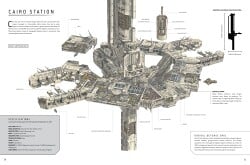
![Quezon Station, one of the Erőd-class ODPs over Reach, alongside its battle cluster.[7]](https://halo.wiki.gallery/images/thumb/a/ad/HFB_ErodClassOWP_Boxart.png/200px-HFB_ErodClassOWP_Boxart.png)
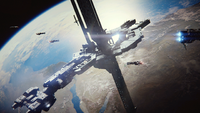
![An unnamed ODP over Reach, firing its main gun. Unlike regular ODPs in which the cannon is aligned vertically with the station's axis, the gun here is laterally-mounted.[12]](https://halo.wiki.gallery/images/thumb/f/fb/Magnetic_Accelerator_Cannon.png/200px-Magnetic_Accelerator_Cannon.png)
![An unnamed ODP uncovered by 343 Guilty Spark within the data banks of UNSC Pillar of Autumn.[13]](https://halo.wiki.gallery/images/thumb/6/6d/Orbitoldefencestation.jpg/200px-Orbitoldefencestation.jpg)
